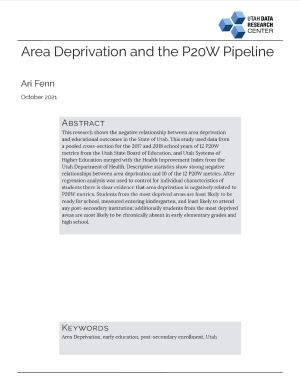Overview
This narrative explores the relationship between Utah's P20W metrics and the overall social and economic health of a given area, known as area deprivation. In addition, it answers the question: Does where a student lives in Utah play a role in their educational and workforce success? This research uses the Utah Department of Health's Health Improvement Index (HII) along with UDRC's unique education and workforce data.
Generally, education outcomes play an important role in determining long-term labor market success. In previous research, UDRC established this relationship in Utah by showing higher spending and higher wages. Additionally, the UDRC has shown how education outcomes vary by differing demographics. This study adds to existing knowledge by establishing a relationship between education outcomes and the area of residence of Utah students.
Summary of Findings
- Before controlling for characteristics of the students, the High and Very High deprived groups have the highest percentage of students with adverse outcomes.
- The Very High deprived areas consistently have a higher proportion of adverse outcomes than the state average.
- The Very Low deprived areas have a lower proportion of adverse outcomes compared to the state average.
- The High and Very High deprived areas have the highest proportion of students who are low-income, experienced homelessness, and are English language learners (ELL).
- The High and Very High deprived areas have a higher proportion of minorities than the Low and Very Low areas.
- Students from the highest deprived areas enter kindergarten as the least likely to be prepared to start school.
- Students from the lowest deprived areas are most likely to be prepared for school when entering kindergarten.
- As HII (deprivation) increases, the probability of being ready for school, entering kindergarten, decreases.
Finding 4: Post-Secondary Attendance
- Students from the Very High deprivation areas are least likely to attend any college or university.
- Students from the Very Low deprivation areas are most likely to attend any college or university.
Finding 5: Chronic Absenteeism
- Students from the Very High deprivation areas are most likely to be chronically absent at the earliest and latest grades.
- Students from the lowest deprivation areas are least likely to be chronically absent in the earliest and latest grades.
- During the middle grades, students from the Very High deprivation areas are less likely than students from the Very Low deprivation areas to be chronically absent.


